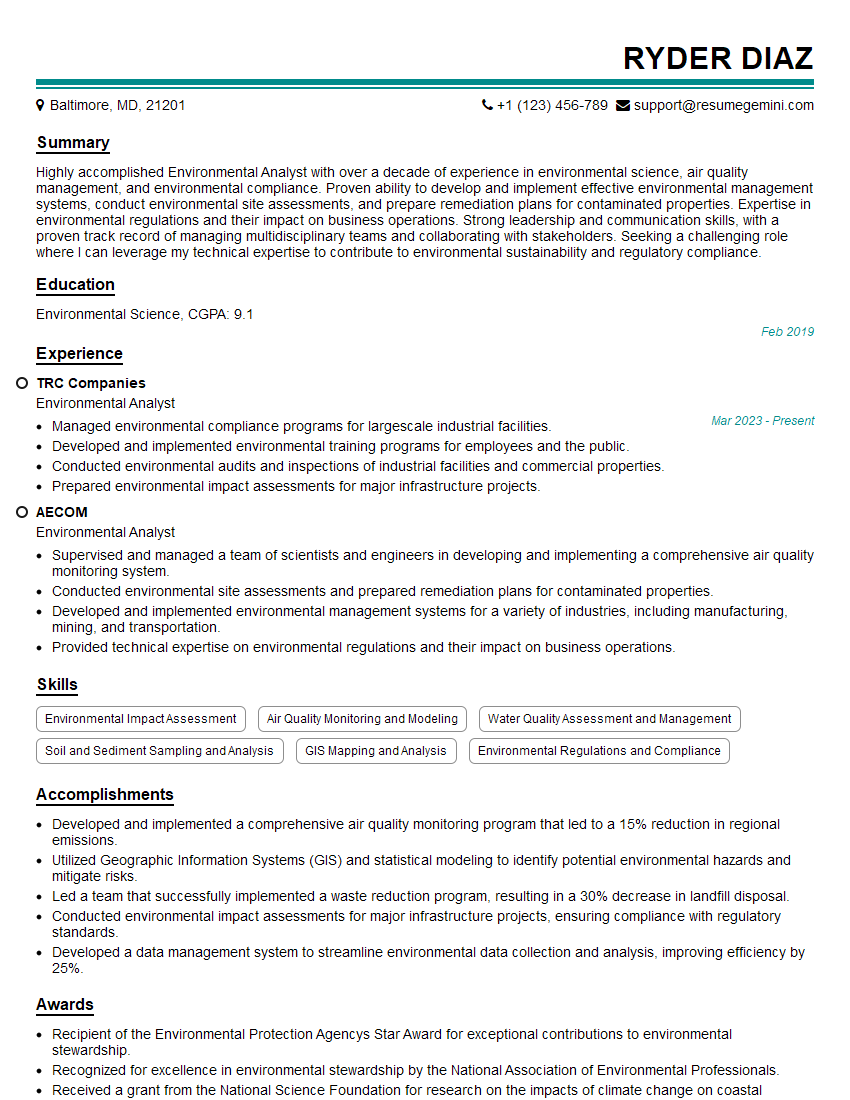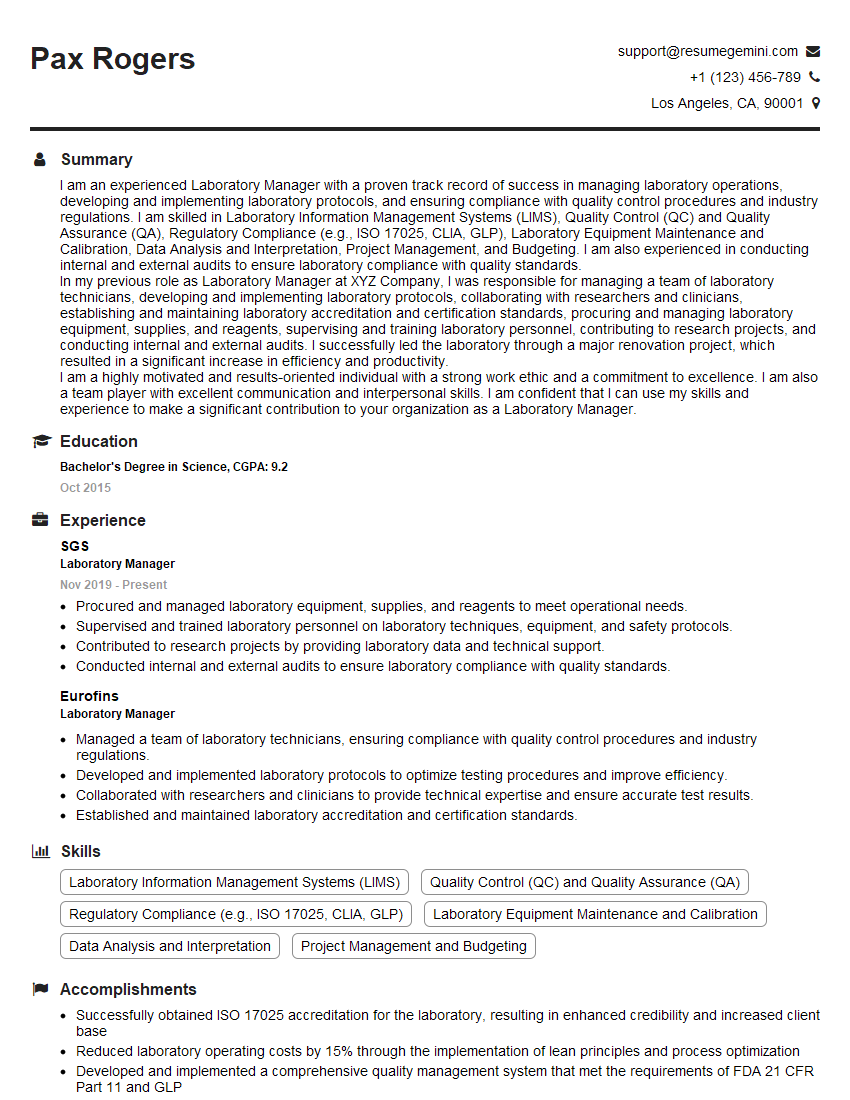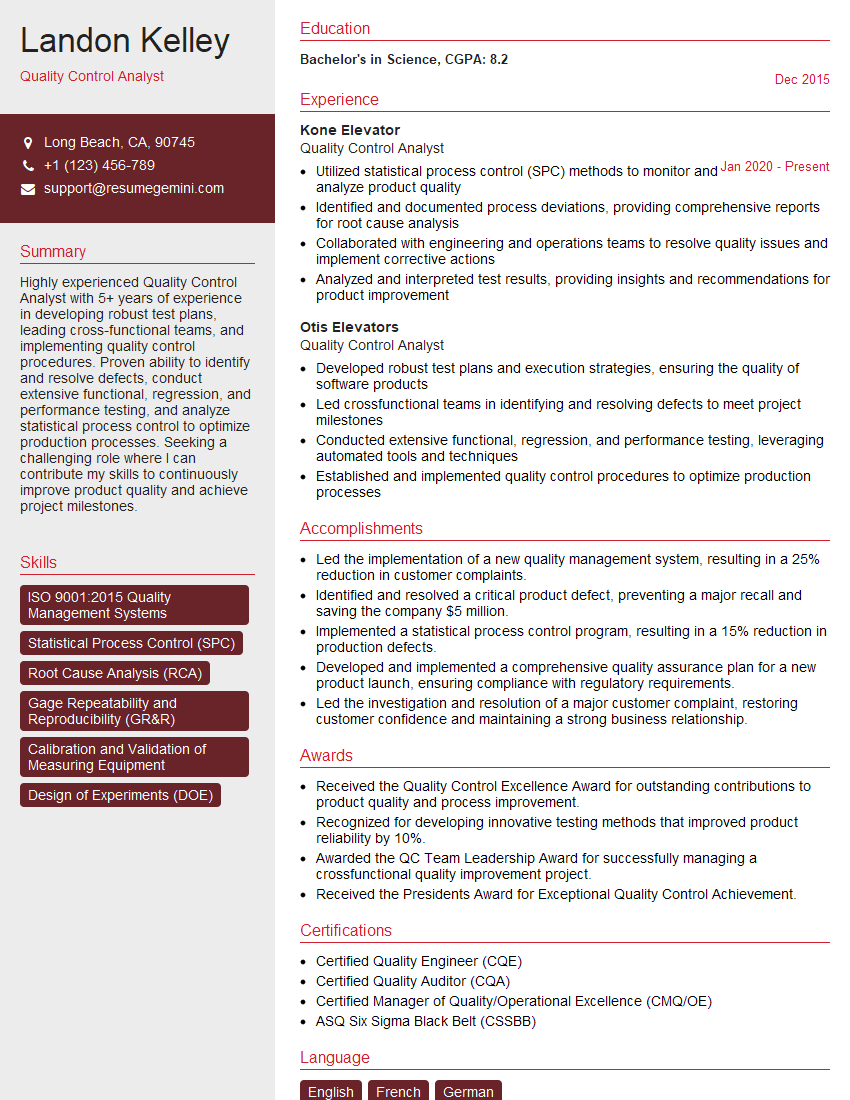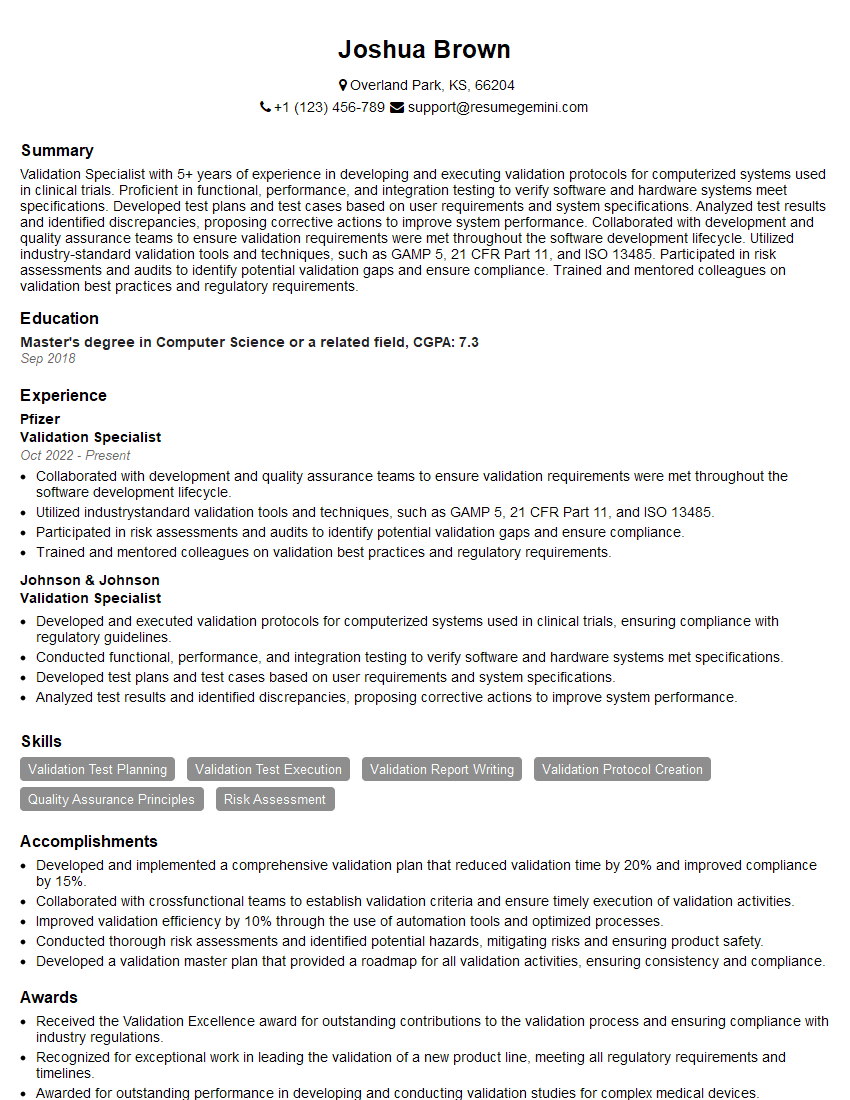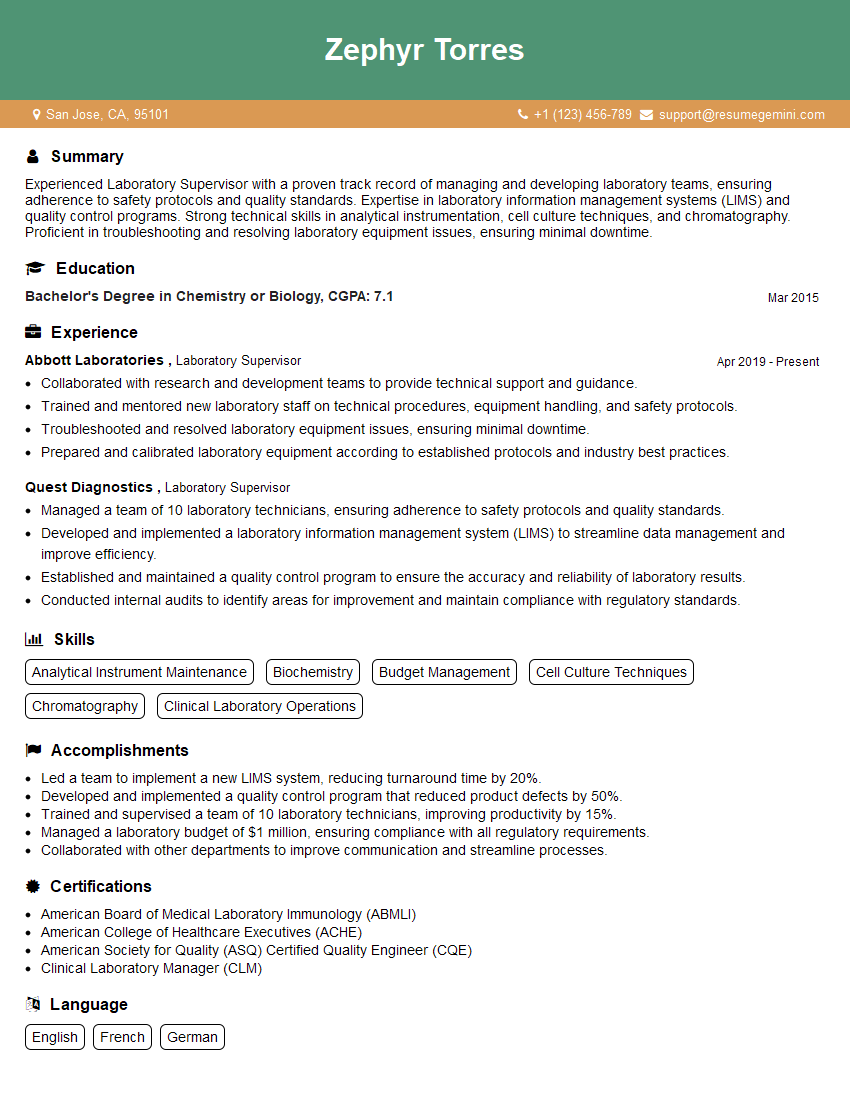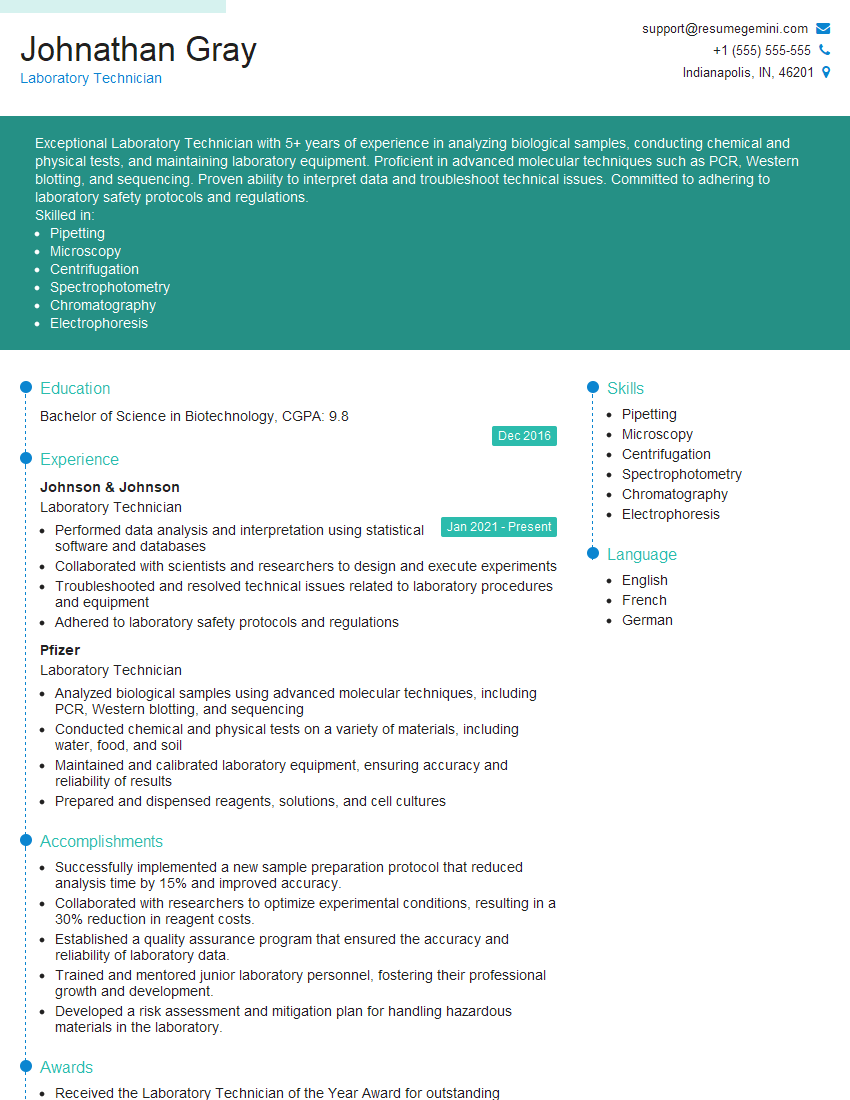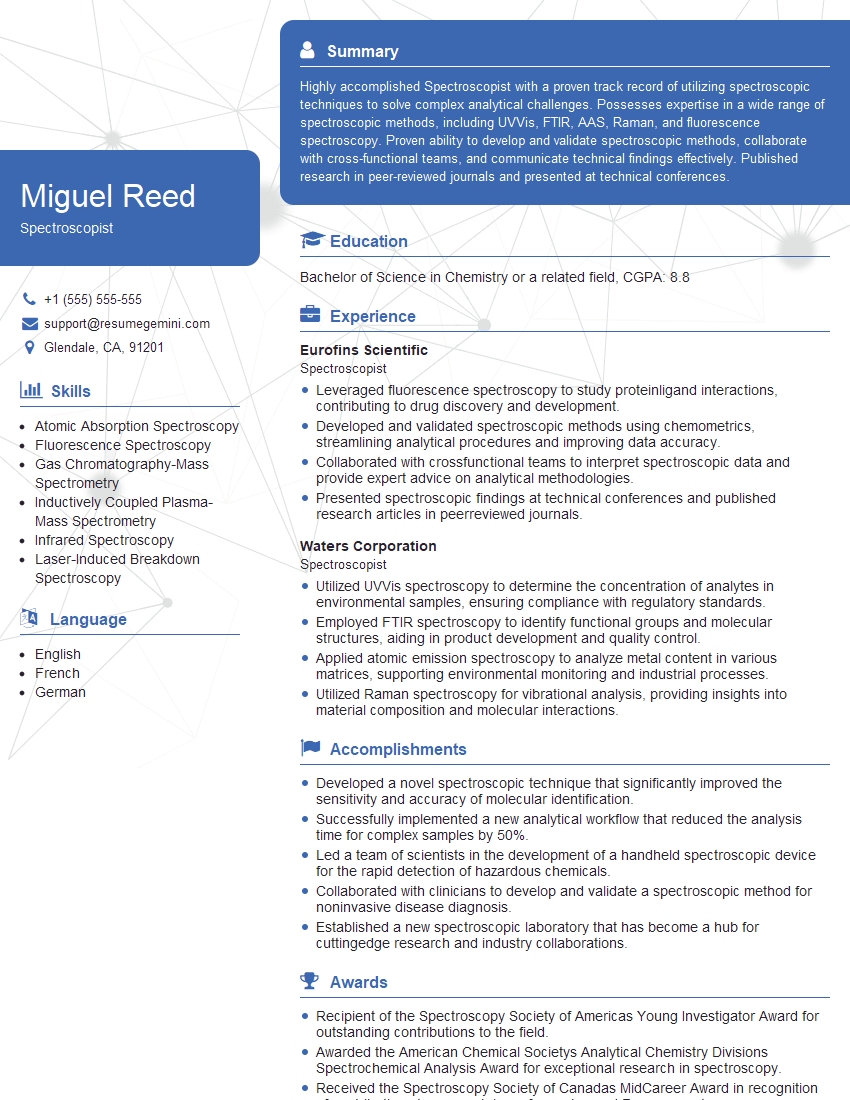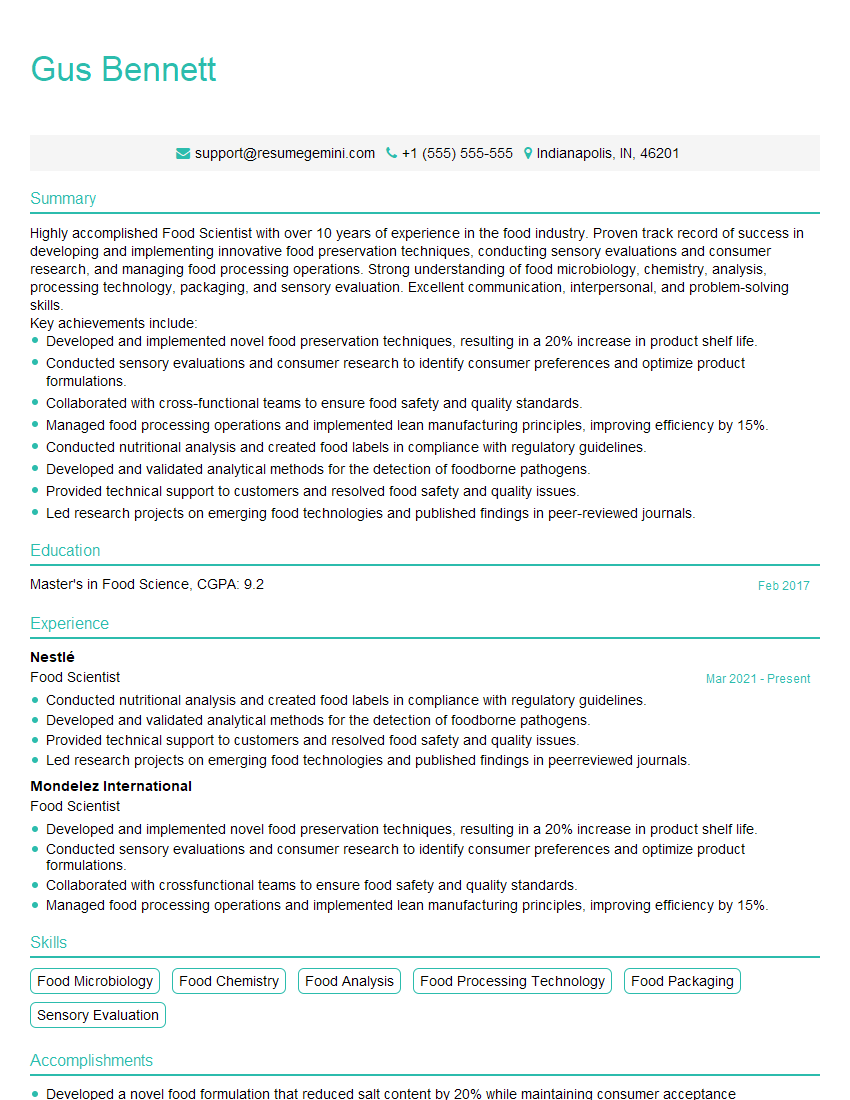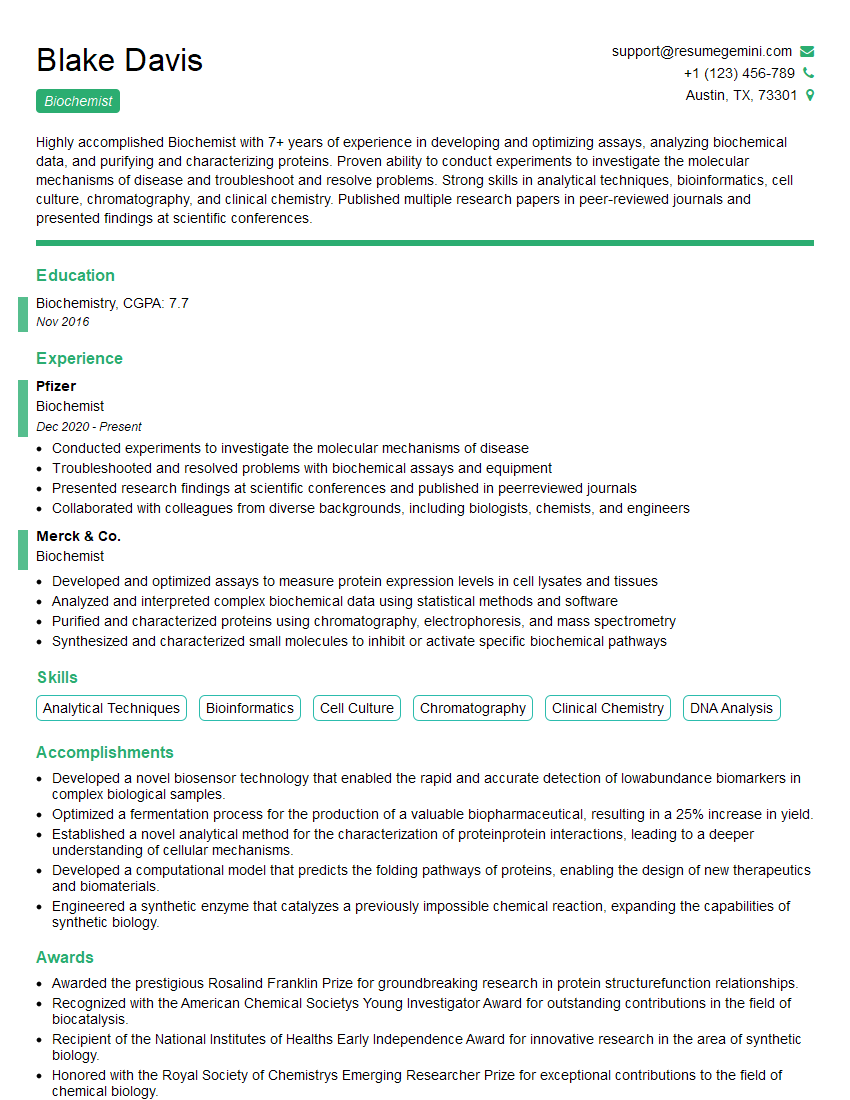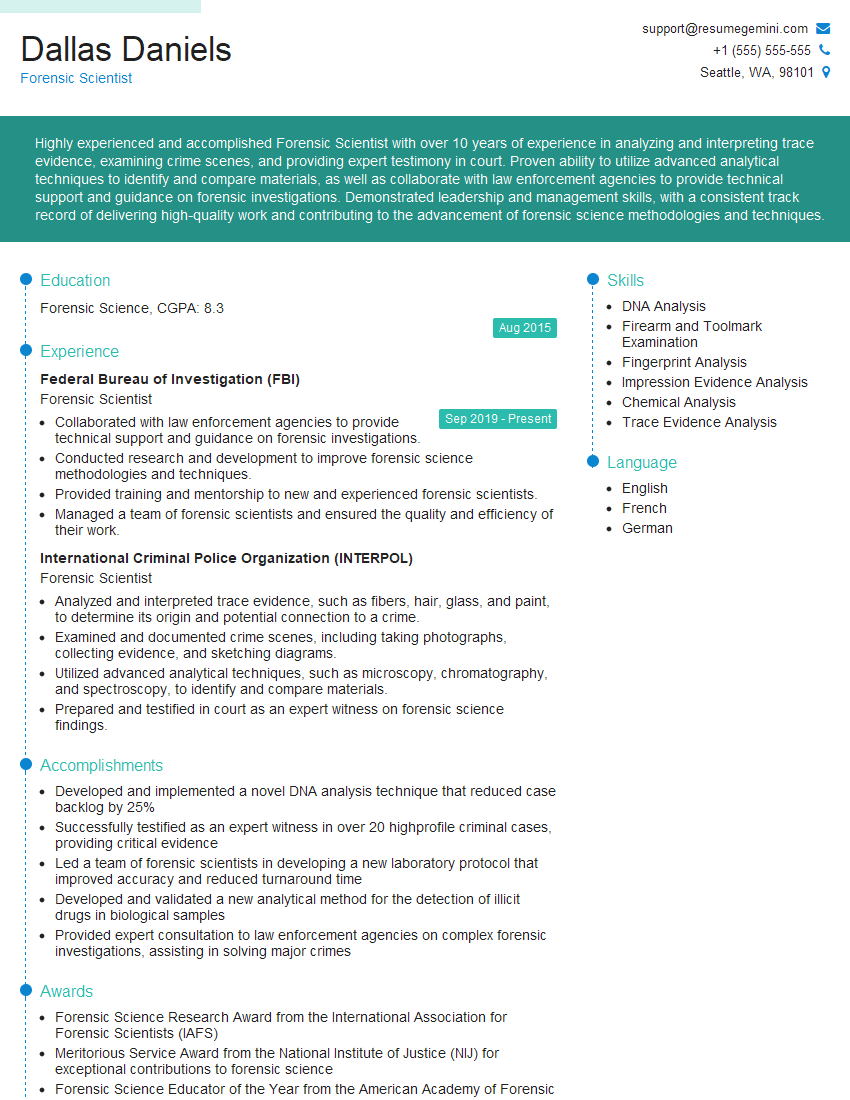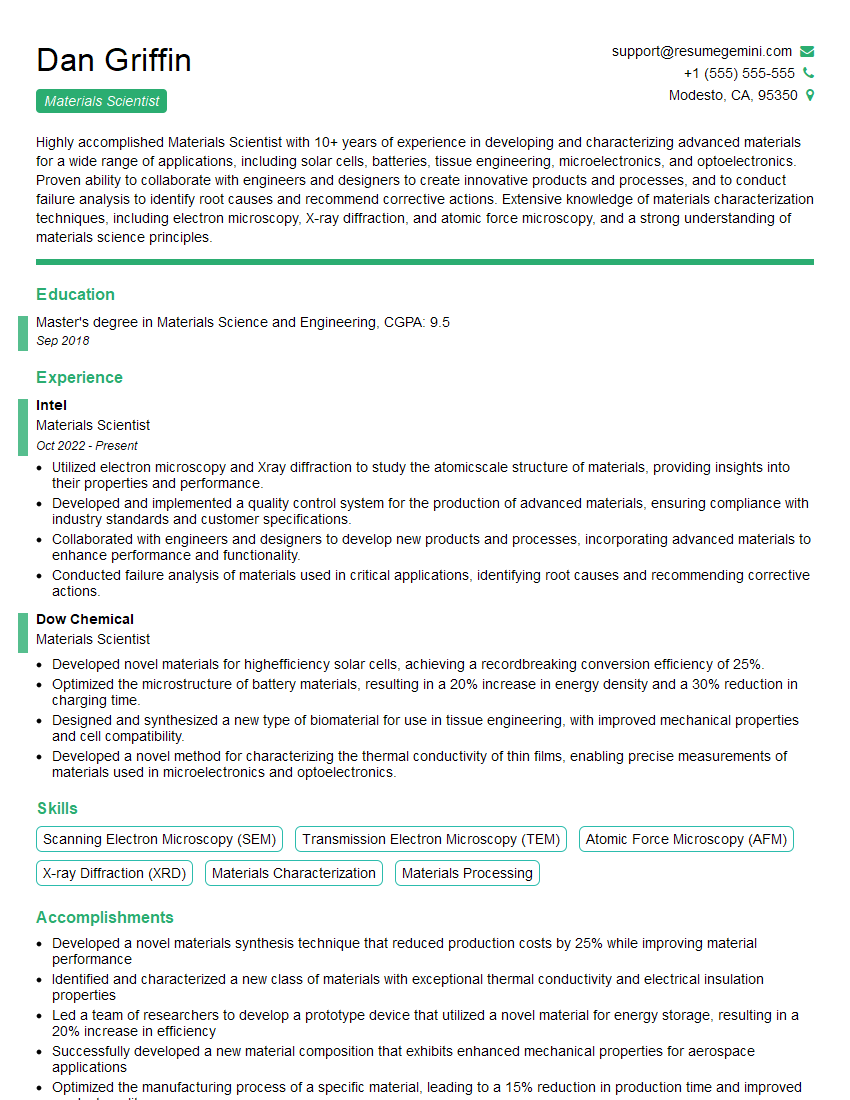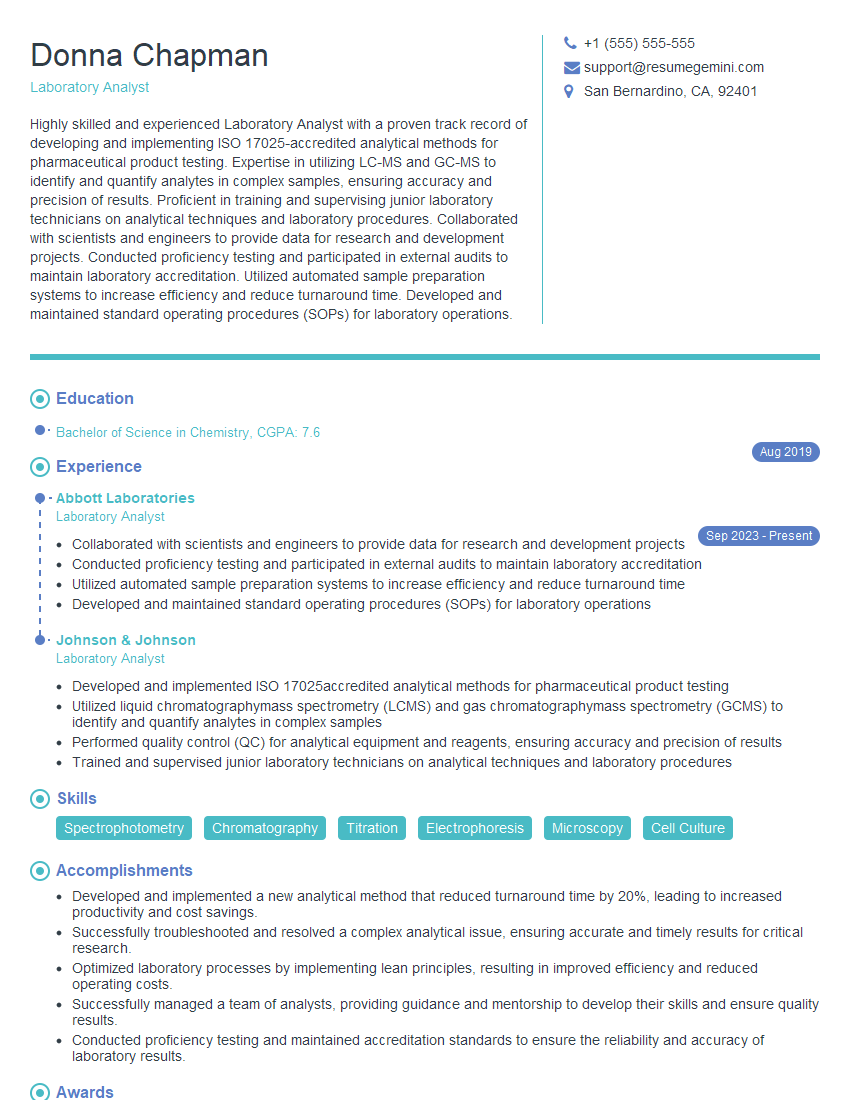Preparation is the key to success in any interview. In this post, we’ll explore crucial Laboratory Analysis and Testing interview questions and equip you with strategies to craft impactful answers. Whether you’re a beginner or a pro, these tips will elevate your preparation.
Questions Asked in Laboratory Analysis and Testing Interview
Q 1. Explain the difference between accuracy and precision in laboratory measurements.
Accuracy and precision are two crucial aspects of reliable laboratory measurements, often confused but distinct. Accuracy refers to how close a measurement is to the true or accepted value. Think of it like hitting the bullseye on a dartboard – the closer your darts are to the center, the more accurate your throws. Precision, on the other hand, describes how close multiple measurements are to each other. This is like consistently hitting the same spot on the dartboard, even if that spot is not the bullseye.
For example, if the true concentration of a solution is 10 mg/L, and you measure it three times as 9.8 mg/L, 9.9 mg/L, and 10.1 mg/L, your measurements are highly precise (close together) and fairly accurate (close to the true value). However, if you measure it as 8 mg/L, 12 mg/L, and 15 mg/L, your measurements are neither precise nor accurate. High precision doesn’t guarantee accuracy, and vice versa; ideally, you want both.
Q 2. Describe your experience with various analytical techniques (e.g., HPLC, GC, Mass Spectrometry).
Throughout my career, I’ve extensively utilized various analytical techniques, including High-Performance Liquid Chromatography (HPLC), Gas Chromatography (GC), and Mass Spectrometry (MS). My experience with HPLC encompasses both reverse-phase and normal-phase chromatography for the separation and quantification of diverse compounds in complex matrices, such as pharmaceuticals and environmental samples. I’m proficient in method development, optimization, and validation for HPLC, including the selection of appropriate columns, mobile phases, and detection methods.
Similarly, my GC expertise extends to various applications, including analyzing volatile organic compounds (VOCs) in air and water samples. I’m adept at using different detectors like FID and ECD, and I understand the importance of proper sample preparation techniques, such as headspace analysis or solid-phase microextraction (SPME). Mass spectrometry has been instrumental in my work, both in tandem with HPLC (LC-MS) and GC (GC-MS), allowing for the identification and quantification of specific compounds based on their mass-to-charge ratio. I’m experienced with different ionization techniques like ESI and APCI in LC-MS and EI and CI in GC-MS. My experience also includes data analysis and interpretation using software like ChemStation and MassHunter.
Q 3. How do you ensure the quality and reliability of laboratory results?
Ensuring the quality and reliability of laboratory results is paramount. This involves a multifaceted approach, starting with meticulous adherence to established Standard Operating Procedures (SOPs) for each analytical method. Regular calibration and maintenance of all instruments are crucial to minimizing systematic errors. We employ rigorous quality control (QC) measures, including the use of certified reference materials (CRMs) and quality control samples (QCs) analyzed alongside the samples. These QCs provide ongoing assessment of accuracy and precision and allow for the detection of any drifts or systematic errors.
Furthermore, we participate in proficiency testing programs, external audits, and internal quality assessments to validate our methods and results against external standards. Maintaining detailed and accurate records, including instrument logs, sample tracking, and raw data, ensures complete traceability and transparency in our work. Data integrity is vital, and we employ electronic data systems that comply with regulatory requirements. Regular training for laboratory personnel on proper techniques and safety protocols also plays a vital role in maintaining high-quality standards.
Q 4. What are the common sources of error in laboratory analysis and how do you mitigate them?
Common sources of error in laboratory analysis can be broadly classified into random and systematic errors. Random errors are unpredictable fluctuations that affect precision, such as slight variations in pipetting or instrument noise. Systematic errors are consistent and repeatable errors that affect accuracy, stemming from things like improperly calibrated instruments, reagent contamination, or flawed methodologies.
Mitigation strategies include using appropriate quality control measures, including replicates and blanks, to identify and assess random errors. Careful calibration and maintenance of instruments, regular reagent checks, and adherence to validated methodologies help reduce systematic errors. Proper training of personnel, the use of certified reference materials, and a well-defined quality assurance program are crucial to minimize all sources of error and ensure the reliability of the results.
For instance, if a balance is not properly calibrated, all weighings will be systematically off, leading to inaccurate results. Careful calibration and regular checks can prevent this. Similarly, improper cleaning of glassware can introduce contamination, leading to erroneous results. Using proper cleaning procedures and blanks help mitigate this.
Q 5. Explain your understanding of method validation and its importance.
Method validation is a crucial process that demonstrates that a specific analytical method is suitable for its intended purpose. It involves systematically evaluating the method’s performance characteristics, such as accuracy, precision, linearity, range, limit of detection (LOD), limit of quantification (LOQ), and robustness. A properly validated method ensures reliable and accurate results, which is critical for making informed decisions based on the analysis.
The importance of method validation is multifaceted. It ensures the reliability and trustworthiness of results used in various applications like regulatory compliance (e.g., pharmaceutical testing, environmental monitoring), quality control, and research. A validated method minimizes errors and biases, increasing confidence in the conclusions drawn from the data. Regulatory agencies often mandate method validation before results can be accepted as valid and reliable. A well-documented validation study provides evidence that the method performs as expected within defined parameters, increasing the credibility and reproducibility of the findings.
Q 6. Describe your experience with different types of laboratory equipment and instrumentation.
My experience encompasses a wide range of laboratory equipment and instrumentation, including:
- Chromatographic systems: HPLC, GC, and their associated detectors (UV-Vis, fluorescence, mass spectrometry).
- Spectroscopic instruments: UV-Vis spectrophotometers, FTIR spectrometers, atomic absorption spectrometers (AAS).
- Electrochemical instruments: pH meters, potentiometers, ion chromatographs.
- Balances: Analytical balances and microbalances for precise weighing.
- Sample preparation equipment: Centrifuges, homogenizers, sonicator, various glassware and laboratory equipment.
I am proficient in operating and maintaining these instruments, troubleshooting common issues, and ensuring their proper calibration and functionality. I also have experience with software used for instrument control, data acquisition, and data analysis.
Q 7. How do you interpret and report laboratory data?
Interpreting and reporting laboratory data requires a systematic approach. First, I carefully review the raw data, checking for outliers or inconsistencies that might indicate errors during the analysis. Then I perform the necessary calculations to obtain the final results, taking into account any dilution factors or correction factors. The results are then expressed with appropriate units and significant figures, reflecting the uncertainty associated with the measurements.
The final report includes a detailed description of the analytical methods used, the sample preparation procedures, the raw data, the calculated results, and an interpretation of the findings. This interpretation is tailored to the specific context and purpose of the analysis, including a discussion of any limitations or uncertainties associated with the results. The report should be clear, concise, and easily understandable, using appropriate visualizations such as graphs and tables to enhance understanding. Quality control data, such as the QC results, are also included to demonstrate the validity and reliability of the obtained results, thereby ensuring transparency and traceability.
Q 8. How do you ensure compliance with relevant laboratory safety regulations and protocols?
Laboratory safety is paramount. Ensuring compliance involves a multifaceted approach, beginning with a thorough understanding of all relevant regulations, such as OSHA guidelines in the US or equivalent standards in other countries. This includes understanding specific hazards associated with the chemicals and equipment used in the lab.
My approach involves meticulous adherence to safety protocols, including proper personal protective equipment (PPE) usage – always wearing lab coats, gloves, and eye protection, as appropriate – and following established procedures for handling hazardous materials. We conduct regular safety training, covering topics such as chemical spill response, fire safety, and emergency procedures. I also actively participate in safety inspections, identifying and reporting any potential hazards immediately. For instance, during a recent inspection, I noticed a faulty fume hood, which was promptly reported and repaired, preventing potential exposure to harmful chemicals. Maintaining detailed records of safety training, inspections, and any incidents is crucial for demonstrating compliance.
- Regular safety training and drills.
- Strict adherence to PPE protocols.
- Proper waste disposal procedures.
- Immediate reporting of any accidents or near misses.
- Maintaining up-to-date safety documentation.
Q 9. What is your experience with LIMS (Laboratory Information Management System)?
I have extensive experience with LIMS, having used various systems throughout my career, including [mention specific LIMS systems used, e.g., Thermo Fisher Scientific SampleManager LIMS, LabWare LIMS]. My proficiency encompasses all aspects of LIMS implementation and utilization, from sample tracking and management to data analysis and reporting. I’m comfortable creating and customizing workflows, defining sample accessioning procedures and managing user permissions. I understand the importance of LIMS in streamlining laboratory operations, improving data integrity, and ensuring compliance with regulatory requirements. For example, in my previous role, I implemented a new LIMS module that reduced sample turnaround time by 20% by automating data entry and analysis. This also enhanced data accuracy by minimizing manual transcription errors. I am adept at troubleshooting LIMS issues and providing training to lab personnel on effective LIMS usage.
Q 10. Describe your experience with troubleshooting laboratory equipment malfunctions.
Troubleshooting equipment malfunctions requires a systematic approach. I begin by assessing the issue, carefully observing any error messages or unusual behavior. Then, I consult the equipment’s operating manual and perform basic checks, such as power supply, connections, and reagent levels. This process often involves checking calibration data and performing basic maintenance, such as cleaning or replacing filters. If the problem persists, I consult with experienced technicians or engineers. For example, I once diagnosed a malfunctioning centrifuge by identifying a loose wire causing intermittent power loss. In another instance, a faulty sensor on a spectrophotometer was identified and replaced, restoring its functionality. Detailed documentation of all troubleshooting steps, including outcomes and any corrective actions, is crucial for future reference and preventative maintenance.
Q 11. How do you maintain the cleanliness and organization of a laboratory workspace?
Maintaining a clean and organized workspace is essential for both safety and efficiency. My approach involves implementing a regular cleaning schedule, including daily cleanup of work areas and a more thorough weekly cleaning. All equipment is kept in designated areas, and surfaces are decontaminated regularly. Reagents are properly labeled and stored according to their chemical properties. I employ 5S methodology (Sort, Set in Order, Shine, Standardize, Sustain) to organize the workspace, ensuring easy access to frequently used items and efficient workflow. This organized space helps minimize the risk of accidents, prevents cross-contamination and improves productivity. A cluttered lab increases the chances of errors and makes it harder to locate essential supplies. For example, color-coding reagent containers by type improves speed and safety.
Q 12. Explain your understanding of standard operating procedures (SOPs) in a laboratory setting.
Standard Operating Procedures (SOPs) are detailed, step-by-step instructions for performing specific tasks within a laboratory. They provide consistency, ensuring that all personnel perform tasks in a uniform manner, maximizing accuracy and reproducibility of results. SOPs are crucial for quality control, minimizing errors, and demonstrating compliance with regulatory requirements. A well-written SOP includes clear instructions, safety precautions, quality control checks, and troubleshooting guidelines. My experience involves developing, reviewing, and implementing SOPs for a variety of laboratory procedures. I understand the importance of regular review and updating of SOPs to ensure they remain current and effective. For instance, I was instrumental in developing a new SOP for a new testing method that improved efficiency and accuracy by 15%.
Q 13. How do you handle discrepancies or outliers in laboratory data?
Discrepancies and outliers in data require careful investigation. The first step is to verify the data’s accuracy by reviewing the raw data, recalculating results, and checking for any errors in data entry or transcription. Next, I would examine the experimental procedure for any potential errors or deviations from the SOP. I would also assess the equipment used, checking calibration records and performing maintenance as necessary. Environmental factors, such as temperature fluctuations, may also be considered. If the discrepancy persists after thorough investigation, I would document the findings, analyze potential sources of error, and potentially repeat the test. Depending on the significance of the outlier, it may be excluded from data analysis after proper justification and documentation. For example, if an outlier is due to a clear procedural error, it should be excluded. However, if the cause is unknown, further investigation would be required.
Q 14. Describe your experience with statistical analysis of laboratory data.
Statistical analysis is fundamental to interpreting laboratory data. My experience includes applying various statistical methods, including descriptive statistics (mean, median, standard deviation), regression analysis, ANOVA, and t-tests, to analyze experimental results. I use statistical software packages such as [mention specific software e.g., GraphPad Prism, R, SPSS] for data analysis and visualization. I understand the importance of selecting appropriate statistical tests based on the experimental design and data distribution. I can interpret statistical results to draw meaningful conclusions, identify trends, and assess the significance of findings. For example, in a recent project, I used ANOVA to compare the effectiveness of three different treatments and found a statistically significant difference between them. This allowed us to recommend the most effective treatment based on the data analysis.
Q 15. What is your experience with calibration and maintenance of laboratory equipment?
Calibration and maintenance of laboratory equipment are crucial for ensuring accurate and reliable results. My experience encompasses a wide range of instruments, including spectrophotometers, HPLC systems, balances, and autoclaves. I’m proficient in performing routine checks, preventative maintenance, and troubleshooting malfunctions. For instance, with spectrophotometers, I regularly verify wavelength accuracy using certified standards and ensure the cleanliness of cuvettes to prevent stray light. For balances, I perform periodic calibrations using certified weights, documenting the entire process meticulously. Preventative maintenance often involves following manufacturer guidelines, such as cleaning lenses, replacing filters, and lubricating moving parts. When troubleshooting, I use a systematic approach, starting with simple checks before progressing to more complex diagnostics, always consulting manuals and documentation to correctly identify and fix issues. Accurate record-keeping, including calibration certificates and maintenance logs, is paramount in ensuring compliance with quality standards.
Career Expert Tips:
- Ace those interviews! Prepare effectively by reviewing the Top 50 Most Common Interview Questions on ResumeGemini.
- Navigate your job search with confidence! Explore a wide range of Career Tips on ResumeGemini. Learn about common challenges and recommendations to overcome them.
- Craft the perfect resume! Master the Art of Resume Writing with ResumeGemini’s guide. Showcase your unique qualifications and achievements effectively.
- Don’t miss out on holiday savings! Build your dream resume with ResumeGemini’s ATS optimized templates.
Q 16. How do you ensure the traceability of laboratory reagents and materials?
Traceability of reagents and materials is fundamental to the validity of laboratory results. We achieve this by implementing a robust system that tracks the entire chain of custody, from the supplier to the final disposal. Each reagent is meticulously documented with its Certificate of Analysis (CoA), including lot number, expiration date, and specifications. We maintain a detailed inventory management system, often using a LIMS (Laboratory Information Management System) or a similar database, to monitor stock levels and expiration dates. This system also allows us to track the use of each reagent in specific experiments. If a problem arises with a batch of reagents, traceability allows us to quickly identify and isolate the affected experiments, preventing erroneous conclusions. Regular audits of our inventory and procedures are conducted to ensure continued compliance with quality standards and regulatory requirements.
Q 17. Explain your understanding of different sample preparation techniques.
Sample preparation is a critical pre-analytical step that significantly influences the accuracy and reliability of laboratory results. The choice of technique depends heavily on the analyte of interest and the matrix of the sample. Common techniques include:
- Liquid-liquid extraction: Separates compounds based on their solubility in different solvents. For example, extracting caffeine from tea leaves using dichloromethane.
- Solid-phase extraction (SPE): Uses a solid sorbent to selectively retain analytes from a liquid sample. This is effective in cleaning up complex samples before analysis. An example is cleaning environmental water samples before pesticide analysis.
- Digestion: Used to break down organic material in samples like tissues or soil, releasing the analytes of interest into solution. Acid digestion is frequently used for heavy metal analysis in soil samples.
- Dilution: Simply reducing the concentration of a sample to match the instrument’s measurement range.
- Filtration: Removing particulate matter from a sample, essential for protecting sensitive instrumentation.
Selecting the appropriate sample preparation method requires a thorough understanding of the sample matrix and the analytical method to be used. It is essential to avoid contamination and maintain the integrity of the sample throughout the preparation process.
Q 18. Describe your experience with qualitative and quantitative analysis.
My experience encompasses both qualitative and quantitative analysis. Qualitative analysis identifies the components of a sample, while quantitative analysis determines the amount of each component. Examples of qualitative techniques I’ve used include thin-layer chromatography (TLC) for identifying different components in a mixture and colorimetric tests to detect the presence of specific substances. For quantitative analysis, I have extensive experience with techniques such as titration, spectrophotometry (UV-Vis, atomic absorption), and high-performance liquid chromatography (HPLC). For instance, I’ve used HPLC for quantifying pharmaceuticals in blood plasma, while spectrophotometry has been used to determine the concentration of proteins in a solution. The choice of technique depends on the required sensitivity, accuracy, and the nature of the analyte and sample matrix. Data processing and statistical analysis are crucial for interpreting the results accurately.
Q 19. How do you manage your time effectively when working on multiple laboratory tasks?
Effective time management in a laboratory setting is crucial for maximizing productivity and meeting deadlines. I employ several strategies, including:
- Prioritization: I identify the most urgent and important tasks and tackle them first. This often involves creating a prioritized task list.
- Planning and Scheduling: I use a daily planner or calendar to schedule tasks, considering instrument availability and potential bottlenecks.
- Time Blocking: I allocate specific time blocks for particular tasks, minimizing distractions and maximizing focus.
- Delegation: When appropriate, I delegate tasks to other team members to optimize workflow.
- Batching Similar Tasks: I group similar tasks together to minimize setup time and improve efficiency.
Regularly reviewing my schedule and adjusting it based on unforeseen events helps keep me on track and prevents unnecessary delays. I also practice mindfulness and stress management techniques to enhance focus and productivity.
Q 20. How do you work effectively in a team environment within a laboratory?
Effective teamwork is vital in a laboratory environment. I believe in open communication, active listening, and mutual respect. I actively participate in team meetings, share my knowledge and expertise, and contribute to problem-solving. I am comfortable both leading and assisting in team projects, always prioritizing the overall success of the team. When conflicts arise, I approach them constructively, seeking common ground and finding solutions that benefit everyone. I believe in fostering a supportive and collaborative atmosphere, where everyone feels comfortable contributing their ideas and sharing their concerns. Collaboration extends to sharing equipment, resources, and knowledge, ensuring efficient and effective workflow. This might involve assisting colleagues with unfamiliar techniques or sharing best practices to improve our overall efficiency.
Q 21. Explain your experience with data analysis software (e.g., Excel, specialized software).
I possess extensive experience with various data analysis software, including Microsoft Excel and specialized scientific software packages. Excel is used for basic data manipulation, plotting graphs, and performing simple statistical analyses. I’m proficient in using Excel functions like AVERAGE(), STDEV(), and LINEST() for data processing. For more complex analysis, I use specialized software like GraphPad Prism for statistical analysis and curve fitting, and specific software packages associated with particular instruments (e.g., chromatography software for HPLC data). I’m comfortable importing data from various instruments into these software packages, performing advanced statistical analysis, and generating publication-ready graphs and reports. My data analysis skills ensure accurate interpretation and clear communication of experimental findings.
Q 22. Describe your experience with preparing laboratory reports and documentation.
Preparing laboratory reports and documentation is crucial for maintaining data integrity and ensuring traceability. My experience encompasses generating comprehensive reports that include all relevant experimental details, results, and interpretations, adhering to stringent quality standards. This includes creating reports for various analytical techniques, such as HPLC, GC-MS, and spectrophotometry. I’m proficient in using LIMS (Laboratory Information Management Systems) to manage data and generate reports efficiently. For example, in a recent project analyzing pesticide residues in food samples, I meticulously documented sample preparation methods, instrument parameters, raw data, calculations, and conclusions, ensuring complete traceability of the entire analytical process. My reports are always clearly written, concise, and easy to understand, even for non-technical audiences. I also have experience creating SOPs (Standard Operating Procedures) which ensure consistent results and are critical for GLP compliance.
Q 23. What is your experience with GLP (Good Laboratory Practice)?
Good Laboratory Practice (GLP) is a quality system that ensures the uniformity, consistency, reliability, reproducibility, quality, and integrity of non-clinical laboratory studies that support the safety assessment of chemicals, including pharmaceuticals, pesticides, and industrial chemicals. My experience with GLP principles is extensive, covering all aspects from initial study design to final report generation. This includes maintaining detailed records of all procedures, equipment calibration and maintenance logs, reagent information, and personnel training. I’ve worked in laboratories fully compliant with GLP regulations, and I understand the importance of maintaining a clean, organized, and well-documented laboratory environment. For instance, I regularly participate in internal audits to ensure our adherence to GLP guidelines. We use a LIMS system to track samples and instruments efficiently. Understanding GLP is essential for the reliability of our data and for complying with regulatory requirements, and I am committed to maintaining these standards at the highest level.
Q 24. How do you stay updated on the latest advancements and techniques in laboratory analysis?
Staying current in the rapidly evolving field of laboratory analysis requires continuous learning. I actively pursue professional development through several avenues. I regularly read peer-reviewed scientific journals like Analytical Chemistry and the Journal of Chromatography. I attend conferences and workshops to learn about the latest advancements in instrumentation and analytical techniques. I also participate in webinars and online courses, which often focus on specific techniques or emerging technologies. Membership in professional organizations, such as the American Chemical Society (ACS), provides access to valuable resources and networking opportunities. Additionally, I regularly check for updates on regulatory guidelines from organizations like the FDA and EPA, which is crucial for ensuring compliance in my work. This multifaceted approach ensures that I remain at the forefront of the field and can apply the most appropriate and efficient methods in my daily work.
Q 25. Explain your experience with developing and validating new analytical methods.
Developing and validating new analytical methods is a significant part of my experience. This involves a methodical approach, beginning with a thorough literature review to assess existing techniques and identify potential improvements. The next step is method development, including optimization of parameters like mobile phase composition (in HPLC), column selection, temperature, and detection wavelengths. Validation is critical, ensuring the method is accurate, precise, specific, and robust. This usually involves analyzing certified reference materials and samples with known concentrations, assessing linearity, detection limits, and repeatability. For example, I recently developed and validated a new HPLC method for the determination of trace impurities in a pharmaceutical product. The process involved rigorous testing, careful documentation, and statistical analysis to demonstrate the method’s suitability. Detailed reports were created, outlining the entire development and validation process, supporting its application in routine analysis. A successful validation ensures reliable and consistent data generation, essential for accurate results and decision-making.
Q 26. How do you handle pressure and meet deadlines in a fast-paced laboratory setting?
Laboratory settings often involve tight deadlines and high-pressure situations. My approach involves effective time management and prioritization. I utilize project management tools to track tasks and deadlines, ensuring that all projects stay on schedule. I am adept at multitasking and prioritizing tasks based on urgency and importance. Furthermore, I proactively communicate potential delays or challenges to my supervisor to find solutions collaboratively. I work well under pressure, maintaining accuracy and attention to detail even when facing tight deadlines. For example, during a period of high sample volume, I effectively prioritized tasks, delegated certain responsibilities where appropriate, and maintained consistent high-quality results within the set deadlines. Effective communication and a proactive approach are key to my success in these demanding environments.
Q 27. Describe a situation where you had to solve a complex analytical problem. What steps did you take?
In one instance, I encountered a complex problem involving an unexpected peak in a GC-MS analysis of environmental samples. Initially, the peak was unidentified, potentially impacting the interpretation of the results. My systematic approach involved several steps: 1. **Re-examination of the sample preparation**: I meticulously checked the extraction and purification steps, ruling out any potential contamination during sample handling. 2. **Literature search and spectral database comparison**: I conducted a comprehensive literature search and compared the mass spectrum of the unknown peak to various databases, searching for possible matches. 3. **Spiking experiments**: To confirm the identity of the unknown, I spiked known standards into the sample to verify if the peak’s intensity correlated with the expected concentration of specific compounds. 4. **Collaboration and consultation**: I discussed the findings with senior colleagues and sought their expertise in spectral interpretation. Ultimately, we identified the peak as a degradation product of one of the target analytes, previously unreported in the literature. This involved comprehensive documentation of each step, ensuring transparency and rigorous scientific investigation. This demonstrated my ability to systematically approach and solve unexpected challenges using a combination of analytical skills, critical thinking, and collaborative problem-solving.
Q 28. What are your salary expectations for this position?
My salary expectations for this position are commensurate with my experience, skills, and the responsibilities involved. Considering my extensive background in laboratory analysis and testing, my proficiency in GLP, and my proven ability to solve complex analytical problems, I am seeking a competitive salary within the range of [Insert Salary Range]. I am open to discussing this further based on a more detailed understanding of the specific compensation and benefits package offered.
Key Topics to Learn for Laboratory Analysis and Testing Interview
- Analytical Techniques: Understand the principles and applications of various analytical methods like chromatography (HPLC, GC), spectroscopy (UV-Vis, AAS, ICP-OES), and electrochemistry. Consider the strengths and limitations of each technique.
- Quality Control and Assurance (QA/QC): Master concepts like calibration, validation, method verification, and quality control charts. Be prepared to discuss your experience with ensuring data accuracy and reliability.
- Laboratory Safety and Regulations: Demonstrate knowledge of safety protocols, handling of hazardous materials, and adherence to relevant regulations (e.g., GLP, GMP). Be ready to discuss your experience maintaining a safe laboratory environment.
- Data Analysis and Interpretation: Showcase your proficiency in analyzing complex datasets, interpreting results, and drawing meaningful conclusions. Practice presenting data effectively using graphs and tables.
- Instrumentation and Maintenance: Familiarize yourself with the operation and maintenance of common laboratory instruments. Discuss troubleshooting experience and preventative maintenance procedures.
- Specific Applications: Depending on the job description, focus on relevant applications such as environmental testing, food safety, pharmaceutical analysis, or clinical diagnostics. Highlight your expertise in your chosen area.
- Problem-Solving and Troubleshooting: Be prepared to discuss instances where you encountered unexpected results or instrument malfunctions, and how you effectively resolved these issues. Emphasize your analytical and problem-solving skills.
Next Steps
Mastering Laboratory Analysis and Testing opens doors to exciting career opportunities with excellent growth potential in various industries. A strong, ATS-friendly resume is crucial for maximizing your job prospects. To create a professional and impactful resume that highlights your skills and experience, we encourage you to utilize ResumeGemini. ResumeGemini provides a user-friendly platform and valuable tools for building a top-tier resume. Examples of resumes tailored to Laboratory Analysis and Testing are available within ResumeGemini to help guide you. Take the next step in your career journey and craft a resume that truly showcases your capabilities!
Explore more articles
Users Rating of Our Blogs
Share Your Experience
We value your feedback! Please rate our content and share your thoughts (optional).
What Readers Say About Our Blog
good
